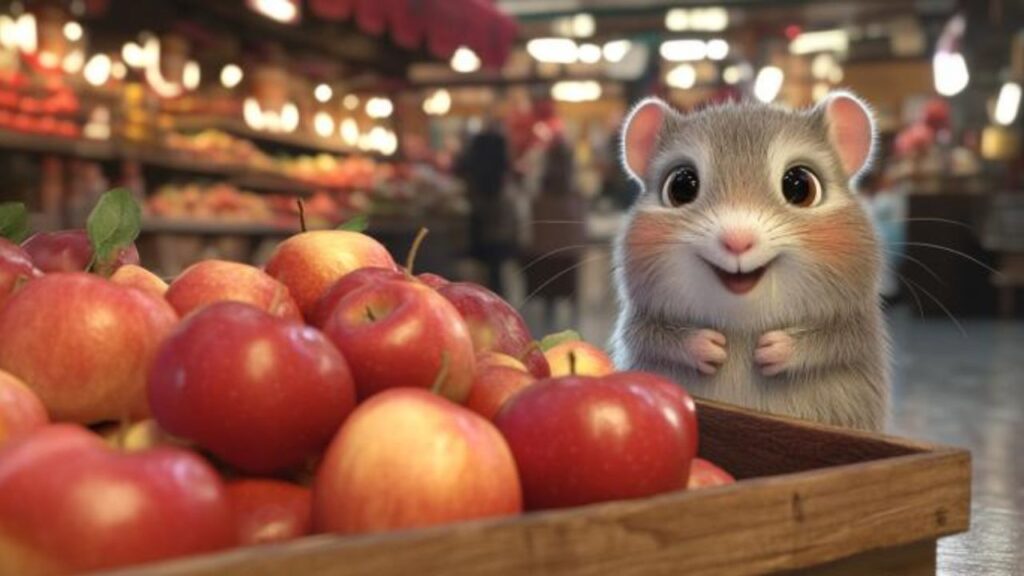TL;DR Summary
Yes, hamsters can eat chicken. It should be cooked plain, without any seasoning, and offered in very small, shredded pieces to prevent choking. Chicken is a beneficial occasional treat due to its high protein content and essential nutrients. However, it should not replace a hamster’s primary diet of pellets, seeds, fruits, and vegetables. Balance and variety are crucial for a hamster’s overall health, so ensure chicken is only a small part of a diverse diet. A happy hamster is a wheel-y happy you!
In the bustling world of hamster care, the dietary habits of these endearing little creatures take center stage. Protein, the powerhouse nutrient essential for almost every bodily function, stands out as a critical element in the hamster dietary chorus. It builds and repairs tissues, supports immune function, and plays a vital role in overall growth and well-being. As such, the inclusion of adequate protein sources in a hamster’s diet is not just important—it’s imperative.
Understanding Protein in a Hamster’s World
Hamsters, much like their human companions, require a balanced intake of carbohydrates, fats, and proteins. This trio of macronutrients ensures that our furry friends maintain their boundless energy and playful demeanor. Protein, in particular, demands a spotlight for its role in sustaining the muscle strength that powers a hamster’s active lifestyle and the structural integrity of each strand of their soft, fluffy fur.
Chicken: A Popular Plate or a Hamster Hazard?
Chicken, a lean and universally popular source of protein among humans, naturally pecks at our curiosity when considering a hamster’s diet. It’s packed with high-quality protein and essential amino acids, but does this mean it can cross the road from our plates to our hamster’s feeding bowl? The suitability of chicken as a protein source for hamsters is a topic ripe for pecking apart. Can these small animals benefit from the same protein-packed bites that we do, or are there hidden perils in such a poultry offering?
As we embark on this investigative journey, let’s sift through the grains of nutritional wisdom to determine if chicken deserves a place in the hamster’s menu or if it should flutter off the table. Stay with us as we unravel the complexities of chicken in a hamster’s diet.
The Nutritional Needs of Hamsters

When it comes to the health and happiness of hamsters, nutrition is a wheel that must be kept in constant, balanced motion. These small, yet energetically complex creatures require a variety of nutrients to live life to the fullest, from the comfort of their bedding to the pinnacle of their exercise wheel.
Essential Nutrients for Optimal Hamster Health
Hamsters, though petite, demand a mighty range of nutrients to support their daily functions and prevent diseases. Here’s a snapshot of their nutritional needs:
- Proteins: Vital for growth and repair of tissues, and absolutely essential during growth, pregnancy, and recovery stages.
- Carbohydrates: Provide energy for daily activities and ensure their little hearts keep pitter-pattering with joy.
- Fats: Essential for energy and the absorption of certain vitamins, fats also keep their fur coat sleek and shiny.
- Vitamins and Minerals: Crucial for bone health, blood clotting, and preventing disease, these are needed in trace amounts but are no less important.
- Fiber: Aids in digestion and keeps their tiny gastrointestinal tracts running smoothly.
The Role of Animal Protein in a Hamster’s Diet
The Chicken Query
Within the protein pillar of a hamster’s diet, animal protein holds a special place. It’s a direct source of essential amino acids that plant-based proteins may lack. Chicken, in particular, is a high-quality source of this macronutrient. It’s lean, rich in amino acids like tryptophan, and contains vitamins such as B12, which a hamster’s body cannot produce on its own.
- Benefits: Chicken, when cooked and unseasoned, offers these benefits in a compact, easy-to-consume form. It’s easily digestible and can be particularly helpful for a growing or healing hamster, providing the building blocks for muscle and tissue without unnecessary fats.
- Considerations: However, the richness of chicken means it should be offered sparingly to prevent obesity and digestive issues. The way chicken is prepared for hamster consumption is also crucial; it must be free from oils, spices, and harmful seasonings.
Chicken in a Hamster’s Diet

When setting the table for a hamster’s meal, one might ponder the inclusion of chicken—a staple in human diets—into their furry friend’s feeding regimen. Understanding the nutritional intricacies of chicken will guide us in making an informed decision on its role in a hamster’s diet.
Nutritional Components of Chicken
Chicken is a dense source of nutrients, tailored by nature to support the growth and maintenance of muscles in both humans and animals:
- High-Quality Protein: Chicken is renowned for its high protein content, providing all the essential amino acids necessary for a hamster’s bodily functions.
- Low Fat: Especially when considering the breast portion, chicken is relatively low in fat, making it a lean choice for an animal protein source.
- Vitamins: It is a good source of B vitamins, particularly niacin (B3) and vitamin B6, which are crucial for energy metabolism and brain health.
- Minerals: Chicken provides minerals such as selenium, which plays a key role in maintaining antioxidant mechanisms in the body.
Benefits of Feeding Chicken to Hamsters
Integrating chicken into a hamster’s diet offers several potential benefits:
- Muscle and Tissue Repair: The amino acids in chicken can support the growth and repair of a hamster’s muscles, particularly after exercise or any health issues.
- Nutrient Absorption: The B vitamins in chicken help ensure that a hamster’s body can properly utilize other nutrients within their diet.
- Palatability: Many hamsters enjoy the taste of chicken, making it a useful treat for encouraging eating in picky or unwell hamsters.
Risks of Feeding Chicken to Hamsters
Despite its benefits, there are risks associated with feeding chicken to hamsters that must be carefully managed:
- Preparation: Chicken must be cooked plain, without any added oils, spices, or seasonings that could be harmful to a hamster.
- Portion Control: Overfeeding chicken can lead to obesity due to its rich protein content; hence, small portions are key.
- Choking Hazard: Chicken should be shredded or cut into small, manageable pieces to prevent choking, especially for smaller hamster breeds.
- Digestive Health: Hamsters have sensitive digestive systems, so introducing any new food, including chicken, should be done gradually to prevent upset.
Whisker Tips: How to Feed Chicken to Your Hamster

When considering adding a dash of poultry to your hamster’s palette, it’s crucial to go about it in a way that keeps their tiny tummies both happy and healthy. Let’s carve out a guide to safely introduce chicken into a hamster’s diet.
Proper Introduction of Chicken
Step 1: Go Plain and Simple
- Cooking Method: Cook the chicken thoroughly without any added oils, butter, salt, or seasoning. Boiling or steaming are the best methods to keep it as natural as possible.
Step 2: The Right Cut
- Preparation: Once cooked, let the chicken cool completely. Then, shred or cut it into tiny pieces that your hamster can easily manage to avoid any choking hazards.
Step 3: The First Taste
- Initial Serving: Offer a small piece of chicken — no larger than the size of a sunflower seed — to your hamster. This first serving is a taste test to see how they react to this new food type.
Step 4: Observe and Assess
- Monitor Your Hamster: After the initial offering, watch your hamster for any signs of digestive discomfort or lack of interest. If they seem to enjoy it and have no adverse reactions, you can consider adding chicken to their diet occasionally.
Quantity and Frequency Recommendations
Portion Size Matters
- Amount: If your hamster passes the taste test with flying colors, you can offer chicken once a week as a protein treat. The portion should not exceed the tiny piece used in the initial test.
Frequency Is Key
- Regular Treat: Chicken should be a treat, not a staple. Limit chicken offerings to once a week to maintain a balanced diet and prevent any nutritional excesses.
Maintaining Dietary Balance
- Mix It Up: Ensure that chicken does not replace the essential components of the hamster’s daily diet, such as their regular hamster pellets and fresh vegetables.
Alternatives to Chicken for Hamster Protein

In the diverse dietary landscape of a hamster’s world, chicken is but one protein-rich pasture to graze. There are a multitude of other protein sources that can add variety to your hamster’s diet while providing essential nutrients. Let’s nibble through some animal-based and plant-based alternatives that can stand in for or alongside chicken in your hamster’s meal plan.
Animal-Based Protein Options for Hamsters
Turkey
- Nutritional Profile: Much like chicken, turkey is a lean source of protein that’s also low in fat, especially when choosing breast meat.
- Comparison: Turkey can be a suitable alternative to chicken, offering a similar range of B vitamins and minerals, but ensure it’s also served cooked and plain.
Mealworms and Crickets
- Nutritional Profile: These insects are naturally part of a hamster’s diet in the wild and are high in protein and essential fatty acids.
- Comparison: They’re a more natural protein source for hamsters compared to chicken and can be given live or dried for added convenience.
Plant-Based Protein Options for Hamsters
Quinoa
- Nutritional Profile: Quinoa is not only high in protein but also contains all nine essential amino acids, making it a complete protein.
- Comparison: It’s a great alternative to chicken for hamsters who enjoy grains, and it can be easier to digest due to its lack of animal fat.
Lentils
- Nutritional Profile: Lentils are a hearty source of protein and also provide dietary fiber, which is beneficial for digestion.
- Comparison: While not a complete protein, they can be mixed with other plant-based foods to create a complete amino acid profile.
Pumpkin Seeds
- Nutritional Profile: These seeds are a good source of protein, healthy fats, and minerals like zinc and magnesium.
- Comparison: They offer a crunch that hamsters love and can be a more occasional treat due to their high-fat content compared to chicken.
Balancing Proteins in Your Hamster’s Diet
While chicken is a commendable source of animal protein, diversifying protein sources is key to a balanced and enriching hamster diet. Each alternative brings its own set of benefits. Insects like mealworms and crickets can simulate the hamster’s natural foraging behavior, while plant-based proteins can offer additional fiber and nutrients not typically found in meat.
Conclusion: Pecking at the Truth About Chicken and Hamster Diets

As we burrow to the end of our dietary dig, we’ve uncovered some clucking good insights about feeding chicken to hamsters. Chicken, with its high-quality protein and array of nutrients, can indeed be a beneficial addition to a hamster’s diet when offered properly.
Feathering the Nest of Nutritional Knowledge
- Chicken as a Treat: In moderation, chicken can provide a boost of essential amino acids that are vital for your hamster’s health, supporting everything from muscle repair to maintaining a luxurious coat.
- Preparation and Portion: The chicken should be cooked plainly and shredded into hamster-sized morsels to prevent any choking hazards, ensuring your pet can safely enjoy this poultry prize.
- Frequency of Feeding: This protein should be dispensed sparingly, with only small amounts given occasionally to avoid disrupting the delicate balance of your hamster’s diet.
The Cornerstone of Hamster Health: Balance and Variety
The takeaway from our feast of facts is that while chicken can be part of a hamster’s diet, it is the balance and variety that truly season their life with health:
- Dietary Diversity: Alongside chicken, a medley of animal-based and plant-based proteins can ensure your hamster gets a comprehensive array of nutrients.
- Nutritional Harmony: Each element of your hamster’s diet should be in tune with their natural needs, reflecting the foraging diversity they would experience in the wild.
As the wheel of wellness turns, we see that chicken can have its place in the small but mighty world of hamster cuisine. Yet, it’s the symphony of a varied diet that will truly make your hamster’s health sing. So, let’s continue to provide our furry friends with the choicest morsels and the richest of care. After all, a happy hamster is a wheel-y happy you!




